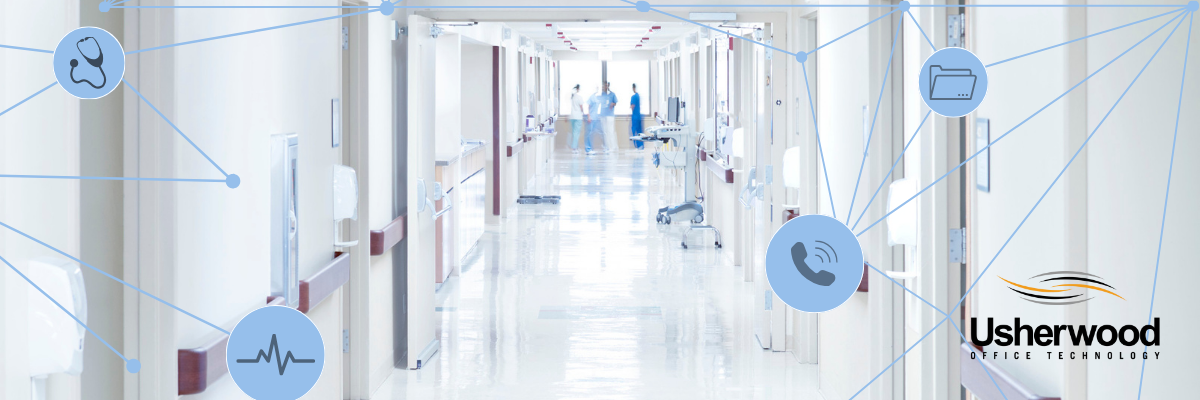By: Jada Sterling, Digital Content Manager on February 29th, 2024
Healthcare Interoperability and How the Cloud Changes the Game
If you run a healthcare organization, you likely know the importance of digital records and user-friendly IT tools for efficiency. There are many services out there that help healthcare businesses manage electronic health records (EHR) through the cloud.
Here are the benefits of interoperability and healthcare and how to leverage the cloud for your health information technology.
Electronic Health Records Changing Healthcare for the Better
According to the Office of the National Coordinator for Health Information Technology (ONC Health IT) 96 percent of hospitals and 78 percent of physicians' offices were using ONC-certified tools to manage healthcare records as of 2016.
The ONC Health IT Certification program requires healthcare businesses to use approved tools listed on the Certified Health IT Product List to become and remain certified. This push to protect and properly manage clinical data has led to the widespread availability of digitized health records.
How Does Information Technology Contribute to Healthcare?
In any healthcare setting, how providers store and retrieve patient data can speed up or slow down visits. More importantly, keeping updated and accurate health data helps providers relay crucial medical records to necessary parties. This can have a direct or indirect effect on the quality of patient care.
If a patient changes doctors, they need their electronic health records sent to the new doctor. The same goes for patients given referrals or prescriptions. For patients to get timely and proper care, information management systems must work together for seamless data sharing.
The need for accurate, secure, and quick health data sharing has caused growth in the healthcare interoperability solutions market.
What is Interoperability in Healthcare? What Are Its Benefits?
According to the Institute of Electrical and Electronic Engineers, interoperability is the ability of IT systems to integrate with other systems without added customer effort. This allows providers to administer more accurate care. Through interoperability, IT systems can interpret information at a glance through standardized connectivity (foundational), data fields (structural), and wording (semantic).
Foundational Interoperability
The Healthcare Information and Management Systems Society defines foundational Interoperability is the ability of one system or application to securely send and receive data from another program. It is the building block of standardization in EHR systems, which you can build upon with more refined integration.
One example is when an IT system receives a document from another program about a patient referral.
However, the receiving system might not understand or interpret the data on its own. It might only receive and provide receipts of the data transfer, allowing users to view the document. This is where structural and semantic interoperability factor in.
Structural Interoperability
Structural interoperability allows different IT systems to communicate with common data formats, data arrangement(syntax), and organization of data exchange. Simply put, this level of uniformity refers to the order and locations of data points on records. This allows for quicker translation between providers and IT systems.
These small details are important for activities like ePerscribing. For instance, details like dosage, refills, and drug ID must be very specific and clear for providers and pharmacists. Having a clear system across programs improves patient care by limiting errors and simplifying prescription fills.
Semantic Interoperability in Healthcare
Semantic interoperability refers to how different types of information are understood and interpreted between organizations. With semantic interoperability, different healthcare systems are able to recognize data through standardized terminology, vocabulary, and values through a universal meaning.
Why is Interoperability Important in Healthcare?
Interoperability reduces barriers to care typically caused by IT issues. According to the American Hospital Association (AHA), barriers to sending, receiving, and finding patient health information include:
- Recipients find information in electronic care summaries unhelpful.
- Inefficient workflows for information transfer from system to system.
- Difficulty matching or identifying the correct patient between systems.
- Challenges related to exchanging data across different vendor platforms.
When your EHR system doesn’t measure up or integrate well with the systems other providers use, it can create headaches for you, collaborating health professionals, and patients.
What is interoperability in cloud computing?
There are many cloud communications platforms to choose from that integrate with popular EHR systems. For example, Intermedia Cloud Communications solutions now integrate with leading EHR systems like Epic Systems Corporation, Cerner, MEDITECH, and more.
If you use a popular EHR tool, research which cloud computing tools work with it for better management. Through cloud integration, users have access to productivity, collaboration, and workload management tools seamlessly blended into their EHR system.
How do cloud-based solutions benefit healthcare providers?
Like any other industry, healthcare businesses stand to benefit from the efficiency and simplicity of cloud communications. All-in-one video conferencing solutions, SMS messaging, voice calling, and file sharing can increase efficiency by:
- Simplifying telehealth meeting creation and scheduling
- Allowing HIPAA-compliant document sharing
- Streamlining team-based care coordination
- Promoting data-driven and patient-centric care
Cloud platforms also come at a lower per-user cost than traditional phone lines. On top of this, there are endless possibilities for long-distance or international calls. In this way, global healthcare interoperability solutions can break down barriers between specialists to enhance patient care.
Compliance and Usability of the Cloud for Healthcare
Cloud-based communications can help both patients and healthcare professionals streamline patient data. Cloud apps like Microsoft Teams make telehealth simple and can be configured for HIPAA compliance. Office team members can easily make voice calls to each other, other providers, or patients without needing analog hardware.
How to Find the Right Interoperability Resources and Cloud Software
Make sure to find a managed communications provider with experience working with healthcare companies. This can ensure they are fully aware of your compliance, patient care, and collaboration needs as a business.
If you're ready to bring your healthcare business into the digital age, click the button below to speak to a managed communications expert.
Read On

Is Microsoft Teams HIPAA Compliant?
Many healthcare providers have pivoted after the COVID-19 pandemic to offer telehealth services....

Print vs Cloud Document Filing Systems for Healthcare
If you run a healthcare business, the odds are you deal with a lot of paperwork. Whether it's for...

The Ultimate Guide to Data Security in Healthcare
Healthcare is an industry often plagued by cyber threats since hackers know the sensitivity of...




